If there is a “big bang” moment in New Zealand’s music history, it was made by the gentlest of melodies. For a delicate song, ‘Blue Smoke’ carries a lot of weight: it marks the real birth of New Zealand’s indigenous record industry. It was the first song written by a New Zealander to be recorded and manufactured in New Zealand – and released on a New Zealand record label. Most importantly for a pop song, it was a hit, a massive hit. Local sales topped 50,000 copies, and Dean Martin and other luminaries recorded cover versions.
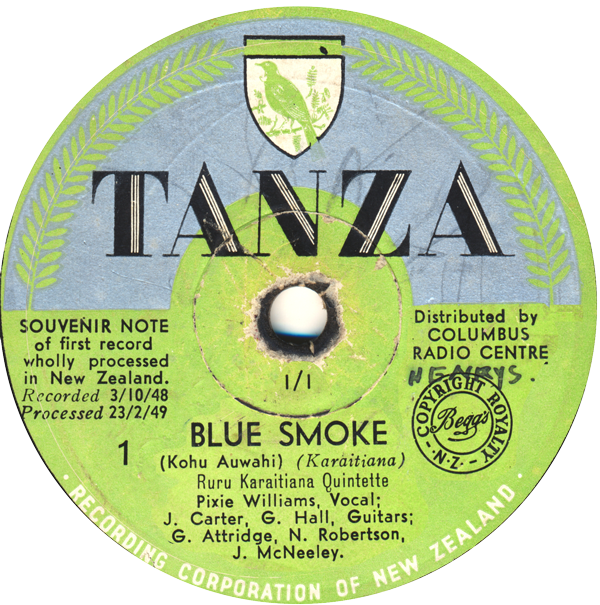
The original 1949 78 of Blue Smoke. It would remain in the Tanza catalogue throughout the 1950s.
It wasn’t the first New Zealand song recorded here: ethnographers Elsdon Best, Johannes Andersen and Āpirana Ngata recorded many Māori songs into a dictaphone-style device or direct-to-disc in the 1920s and 1930s. During the same period, New Zealand – or rather, Māori – songs were recorded in Australia and England by performers such as Ana Hato, Deane Waretini and Ernest McKinlay. These were released on overseas labels such as Columbia and Parlophone. Also, in the 1930s, many musicians and bands recorded acetates in New Zealand studios designed for making radio advertisements – but these were only pressed in limited numbers, and not commercially released.

Blue Smoke – the sheet music version of Ruru Karaitiana’s song, published by Begg’s. This piano arrangement by George Winchester came out in 1947, two years before the Tanza record.
‘Blue Smoke’ was written in May 1940 on board the TROOPSHIP ‘Aquitania’.
‘Blue Smoke’ was written in May 1940 on board the Aquitania, the troopship taking the Māori Battalion to the Second World War. Among the soldiers in D Company was a dance band leader and multi-instrumentalist from Dannevirke, Private Ruru Karaitiana. He recalled that one day off the coast of Africa, “halfway across the Indian Ocean”, he was sunbathing on the deck when a sergeant came along, stopped beside him, and looked up: “Look at that blue smoke,” he said, pointing up to the smoke drifting from the funnels. “It’s going the right way – back to New Zealand – and we’re steaming farther from home.”

Blue Smoke composer Ruru Karaitiana in his army uniform, late 1940s
Karaitiana said later, “these things are simply a matter of luck. He put the song in my lap. It was a natural.” Within half an hour he had written the lyrics “in his head” to a melody he had been working on before the war. Two days later he sang it in a shipboard concert. An Australian nurse on board recalled meeting him on the Aquitania, and that he sang ‘Blue Smoke’ accompanying himself on a ukulele. Also, other soldiers began performing it casually.
Six weeks later, the Aquitania arrived in England, where the New Zealand troops stayed for six months. During this time, Karaitiana went to London and offered the song to Chappell, the well-known music publishing company. But they turned him down. In January 1941 he left Liverpool with the Māori Battalion on board the Athlone Castle, heading for Egypt.
Karaitiana was wounded in the Middle East, and also spent some time confined to barracks for minor offences such as gambling. There are reports of him leading a 17-piece “concert orchestra” of the Māori Battalion, many of whom later died on Crete. ‘Blue Smoke’ became a regular item at sing-alongs by members of the Māori Battalion.
In 1943 Karaitiana returned back to New Zealand with a “non-medical discharge” from the army, being “unfit for service”. Three years later, he began organising dances and leading his own band in a hall in Dannevirke. In the interim, he had been working as an itinerant musician and shearer, between Napier and New Plymouth, and as far south as Wellington. Wherever he went, he played ‘Blue Smoke’ and explained how it came to be written on the Aquitania.
In this way ‘Blue Smoke’ seemed to take on a life of its own. As early as 1945 it was performed by a sextet at a student capping revue in Dunedin. The RNZAF band and many other dance bands also performed it immediately after the war. Among them was Dunedin’s long-established Dick Colvin Orchestra, with an unknown female singer on the New Zealand Broadcasting Service’s radio programme New Zealand Presents.
In October 1946 a 17-year-old soprano called Jean Ngeru recorded the song in Hāwera when the NZBS’s Mobile Recording Unit visited the Taranaki town to capture the sounds of regional music-making. The recording lay forgotten in the radio archives for decades until it was discovered by musicologist Allan Thomas in the early 1990s.
Ngeru performed the song as a brisk waltz, accompanied only by a strumming guitar. A year later, Wellington pianist George Winchester arranged the song for its publication as sheet music by Begg’s, with lyrics in English and Māori (‘Kohu-Auwahi’). At this time Karaitiana would often step into the Wellington branch of Begg’s music store and play ‘Blue Smoke’ on the grand piano by the front door. It would be another two years before Pixie Williams’s recording was the debut release for Tanza Records in June 1949.
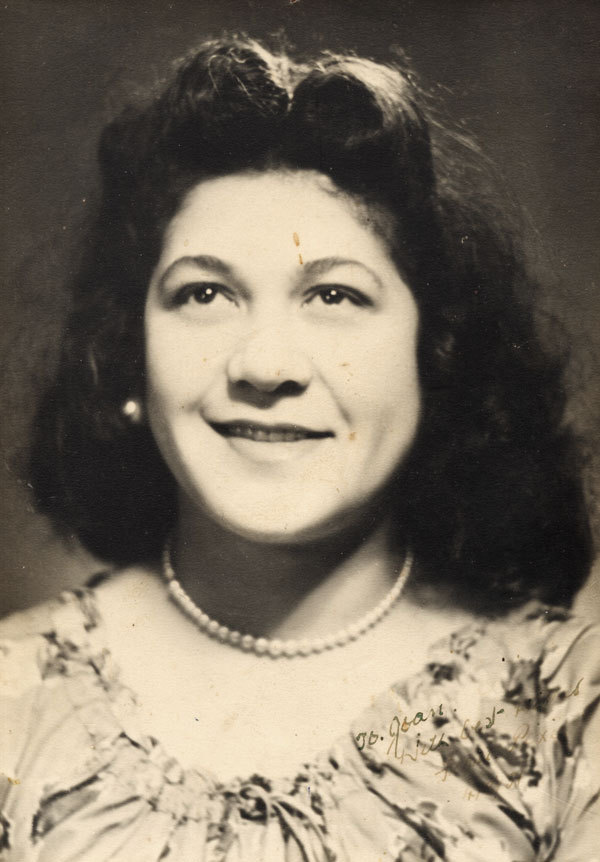
Pixie Williams in 1949, the year her recording of Blue Smoke was released - Courtesy of the Karaitiana family
The release of ‘Blue Smoke’ was a cultural breakthrough, and Tanza’s sales and marketing manager Bart Fortune was aware of its importance. He came up with the company’s name – an acronym for “To Assist New Zealand Artists” – and its label design, a tui flanked by ferns. He also wrote these lines to be printed on the label, alongside the song’s title:
SOUVENIR NOTE
of first record
wholly processed
in New Zealand
Recorded 3/10/48
Processed 23/2/49
Fortune was making a point, because there was a war on. Not the Second World War, without which ‘Blue Smoke’ would never have been written. No, this was an industrial war, between British multi-national record company His Master’s Voice and anyone in New Zealand who wanted to record and release local artists.
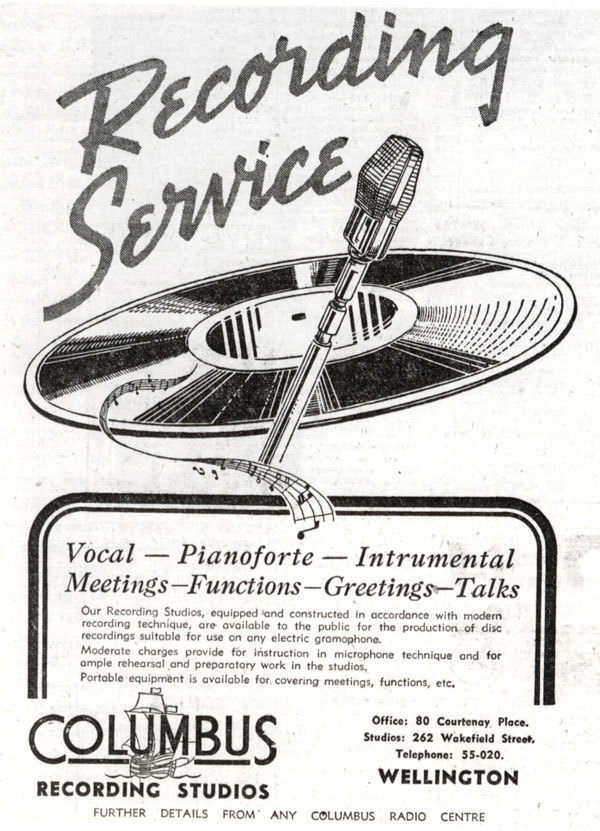
An advertisement in the 8 October 1948 Listener announces that Radio Corp’s Columbus Recording Studios was open for business in Wellington
Tanza was established by the Radio Corporation of New Zealand, a public company that manufactured radios and gramophones. To do this, they established a chain of about 30 stores in most of the cities and major towns around New Zealand. They were called Columbus Radio Centres after their showcase product, the large, wooden Columbus valve radios.
Radio Corp wanted to sell records alongside the gramophones at their Columbus stores, but as HMV had distributorships in most towns, it refused to supply the Columbus stores with stock. So the Columbus chain had to make do selling records from very minor labels, with the exception of two stores: Dannevirke and New Plymouth, where HMV did not have a distributor.
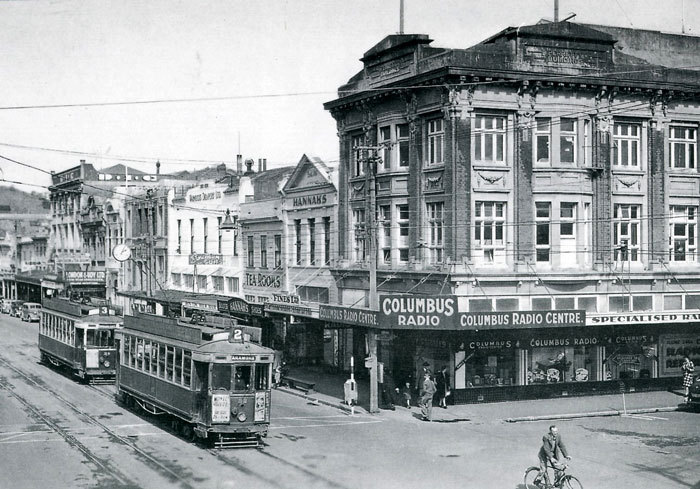
The Columbus Radio Centre, Victoria Avenue, Wanganui. In the mid-1940s these stores – the retail arm of Radio Corp – were prominently placed in 27 New Zealand cities and towns. They sold the firm’s radios and gramophones – and Tanza discs.
When HMV suddenly refused to supply its weekly box of 78s to Radio Corp for these two stores, it hastened Radio Corp’s plan to start a record label of its own, to circumvent HMV’s monopoly – and support local artists. The company already had a fledgling recording division, which made direct-to-disc recordings of advertisements, weddings and race meetings.
Ruru Karaitiana was in the perfect position to provide a song for Tanza’s first release.
Radio Corp hired Stan Dallas – technician at Wellington’s 2ZB radio station – to build a studio suitable for recording music at 262 Wakefield Street, a block away from Radio Corp's manufacturing and retail base at 80 Courtenay Place (a block away from Te Papa’s current location). Dallas designed and built the recording equipment and pressing plant from scratch – including the microphones – and copied the layout of the 2ZB control room.
Ruru Karaitiana was in the perfect position. He had a song that was already well-known and being widely performed on marae, in shearing sheds, and dance halls. How the song came to be selected by Tanza is unknown. John Shears, who worked for Tanza at the time, and assisted Stan Dallas during the recording sessions, suggests that Karaitiana just kept “hammering away” at Tanza staff until they thought, “Well, let’s try this guy – we liked the song right from the word go.”
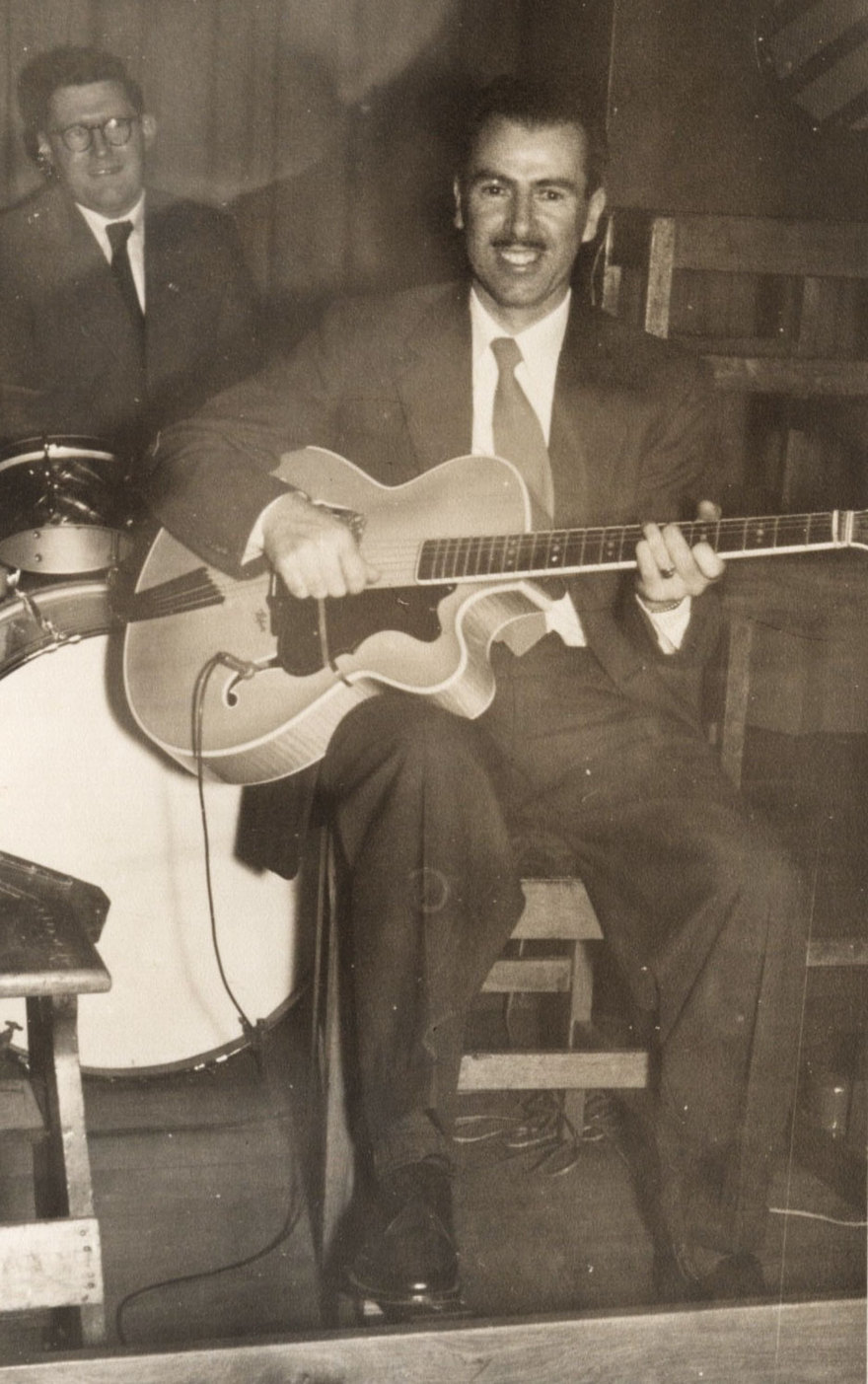
Jim Carter on his Spanish semi-acoustic guitar, Wellington, early 1950s.
Karaitiana approached lap-steel guitarist Jim Carter, to ask if he could use Carter’s Hawaiian band on the recording. Karaitiana’s girlfriend Joan Chettleburgh suggested a friend from her hostel as the singer: Pixie Williams, a 19-year-old from Mohaka, Hawke’s Bay, had impressed Joan at hostel sing-alongs. She reluctantly agreed.
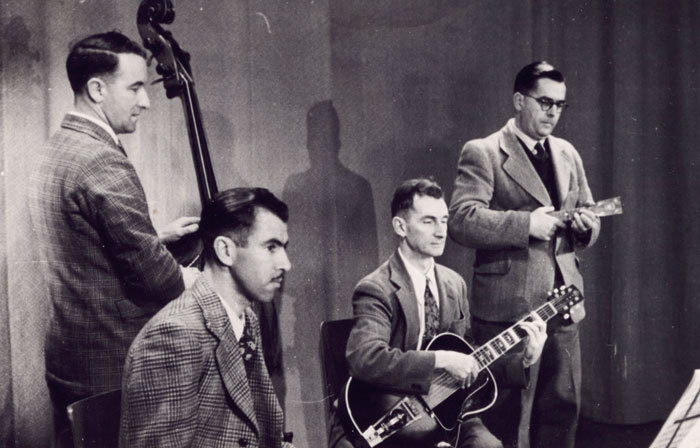
Jim Carter’s band, 1949 – as the Ruru Karaitiana Quintette they recorded ‘Blue Smoke’ with Pixie Williams. From left, Noel Robertson, Jim Carter, Gerry Hall and George Attridge. (Robertson was the regular bassist; on the recording, Johnny McNeely played bass.)
The sessions took place over several weekends, as Dallas struggled to get a good recording in the new studio. Re-named the Ruru Karaitiana Quintette, the backing band was Jim Carter on lap steel, George Attridge on ukulele, Johnny McNeely on bass and Gerry Hall – usually a drummer – on guitar. (Carter’s regular bassist Noel Robertson is also listed on the label: “Everyone wanted their name on it,” said Carter.)
Some takes of ‘Blue Smoke’ were allegedly ruined by the noise of a fridge next door, another by Karaitiana himself. Carter recalled: “He came in at the end before we’d finished and said, ‘Oh, that’s a good one.’ So that killed that!”
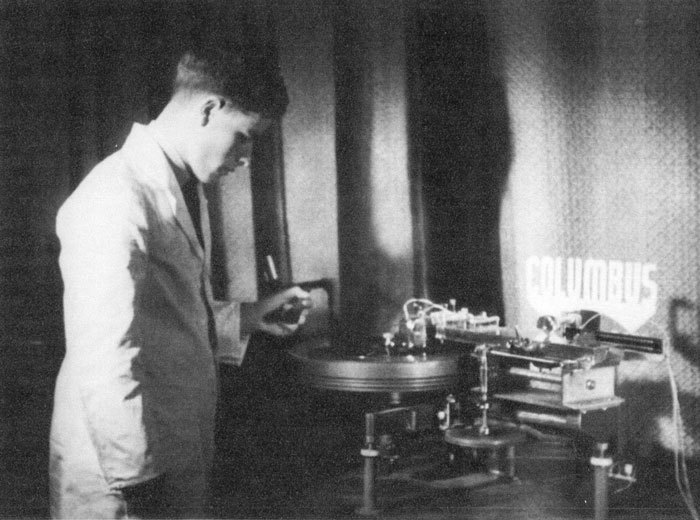
John Shears of Tanza “watching the swarf” – the highly inflammable shavings producing during record cutting, June 1949
When the record was finally released in late June 1949, it received wide publicity. There were window displays in Columbus stores throughout the country, and in cinemas the National Film Unit’s Weekly Film Review featured an item which showed the Karaitiana Quintette recreating the recording session, and the pressing equipment (Pixie Williams was absent, having decided to follow her heart to the South Island.) The Southern Cross newspaper declared the release of ‘Blue Smoke’ to be “an outstanding New Zealand industrial achievement”.

In June 1949, with the release of Blue Smoke imminent, the Ruru Karaitiana Quintet re-created the recording session at the National Film Unit’s Miramar studio. From left: Jim Carter, steel guitar; Noel Robertson, bass; Gerry Hall, guitar; George Attridge, ukulele; and Ruru Karaitiana, songwriter. Pixie Williams left Wellington not long after the release of the disc, so she wasn’t present.
In 1992 Dallas told writer Gordon Spittle that ‘Blue Smoke’ “happened to come along at the right time. It had a strong Hawaiian background, Pixie Williams had a voice attractive to what we wanted – a good husky different voice – but the background was strictly Hawaiian. Why was it so popular in New Zealand? It is easy listening, middle-of-the-road – it still is. You could not go wrong.”
Dallas confirmed that the sales of ‘Blue Smoke’ when it was first released by Tanza on 78rpm disc in 1949 were “at least 50,000”. These numbers were phenomenal in a country with only 1.8 million people, and for records distributed mainly through the Columbus stores. HMV refused to distribute any discs released by the fledgling independent, or sell them in its stores.

Ruru Karaitiana examines an unknown 78rpm disc for a photographer, c. 1950.
Only a month after its release in New Zealand, a cover version came out in Britain recorded as a duet by Webster Booth and Anne Ziegler. They had met Karaitiana a year earlier while visiting Wellington. In the United States, the Sam Fox Publishing Company started plugging the song and it would soon be “waxed” by Leslie Howard, Dean Martin, and many others. Karaitiana was surprised to get a phone call in Dannevirke from Dean Martin in the US, asking if he had any more songs.
Success has many fathers, the saying goes: failure is an orphan. After the unprecedented success of ‘Blue Smoke’ some doubted that Karaitiana wrote the song. In Wellington, John Shears was regularly confronted by the local representative of Albert’s publishing company, the formidable Miss Fanning, that the song was a re-write of ‘Carolina Moon’, a 1929 hit by US singer Gene Austin. But the songs are only superficially similar, and accusations of plagiarism would not stand up to detailed analysis of the melody, chords or structure. (In 1955 Truth newspaper swiftly recanted after running a catty letter from Auckland vaudevillian Neville Carlsen suggesting ‘Blue Smoke’ was ‘Carolina Moon’ in disguise.)
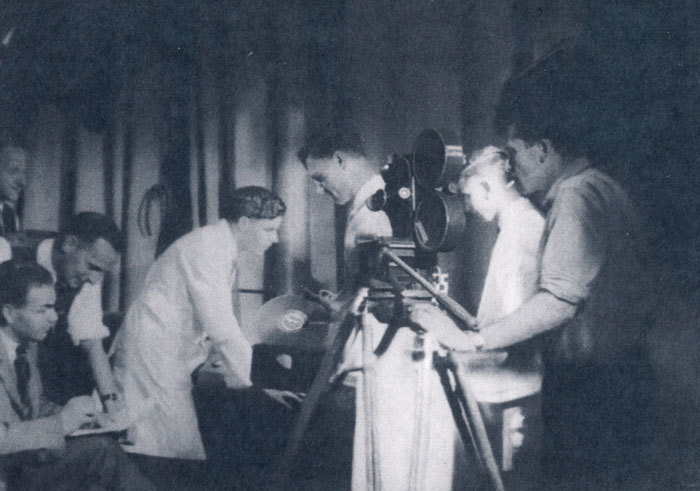
Six months after the recording of Blue Smoke, the National Film Unit recreated the occasion for a newsreel to screen in the week the disc was released in June 1949. The trio of white-coated Tanza staff is, from left, John Shears, Tony Hall and Stan Dallas. Leaning over at left, in shirtsleeves, is Bart Fortune, label manager and creator of the name “Tanza”: to assist New Zealand artists.
Before Karaitiana returned home in March 1943, ‘Blue Smoke’ had been widely heard by New Zealand troops in the Middle East. At least two claimed to have collaborated with him in its composition. One, a barroom pianist known for unreliability, may have crossed paths with Karaitiana in the Middle East; crucially, he left New Zealand four months before Karaitiana. Another claimant was a Māori officer from a musical family in Hawke’s Bay, who was also on the Aquitania in D Company when it left Wellington on 2 May 1940. He returned to New Zealand almost three years after Karaitiana, by which stage both ‘Blue Smoke’ and its composer were well-known. More research and, ideally, documentary evidence is needed to examine this claim, however the fact Karaitiana would go on to write and publish a small portfolio of songs makes a strong case for his ability to write ‘Blue Smoke’.
Stan Dallas had no doubts that Karaitiana wrote the song. “I worked quite closely with him in that period and I’m absolutely convinced that Ruru wrote it, no problem about that at all. All the stories that it was somebody else were absolute nonsense.”
Karaitiana was known for his “extreme reticence”; he was a shy man who came alive at the keyboard. He commented once that ‘Blue Smoke’ was a “poor first effort”, and that he’d never liked the song. “I think he was wrong there,” said Jim Carter in 2008. “It’s only a song – but it’s got something."
--
The story of how ‘Blue Smoke’ became well-known around New Zealand before the Tanza recording continues to fascinate. In April 2019, Ngā Taonga – the New Zealand sound and vision archive – found a recording on a 78rpm acetate of the song being performed in May 1945 by the Otago Capping Sextet, just as the Second World War ended. Before this discovery, the earliest recording was thought to be by Jean Ngeru, a 17-year old singer from Hawera, performing for the National Broadcasting Service’s mobile recording unit. In 1951, 20 seconds of an instrumental version are heard a dance scene of the short film drama Aroha (see link below).
--
Update: on 15 August 2019 it was announced that Ruru Karaitiana, Pixie Williams, and Jim Carter will be inducted into the New Zealand Music Hall of Fame at the 2019 APRA Silver Scroll Awards in October. The Hall of Fame was created in 2007 by APRA AMCOS and Recorded Music New Zealand.
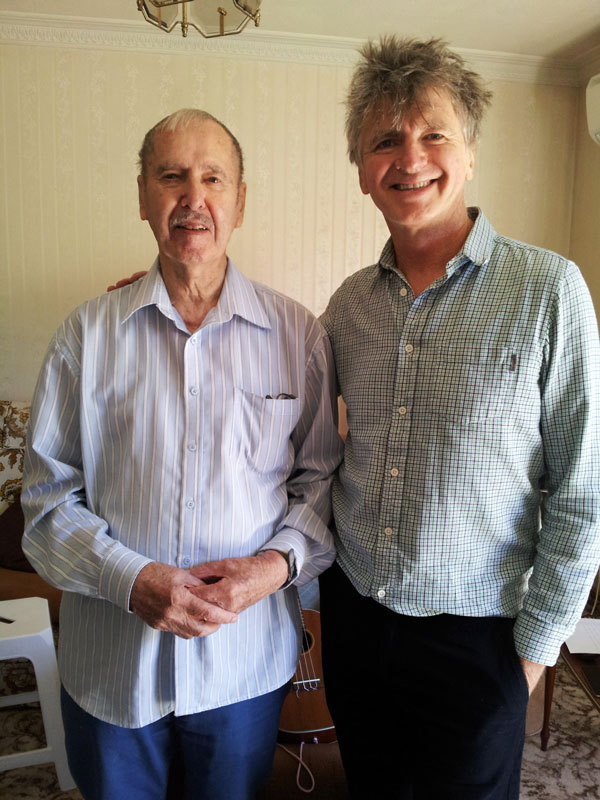
Jim Carter with Neil Finn (right), after recording a new version of Blue Smoke in his Nelson living room, 13 February 2015 - Photo by Chris Bourke
A recording made in 1951 at Tamatekapua, near Rotorua:
Footage of a dance band playing Blue Smoke at the Tamatekapua wharenui, from the short drama 'Aroha: A Story of the Māori People', a period piece directed by Michael Forlong for the NFU in 1951. On the Ōhinemutu marae, near Rotorua, the "Tama" is where dance band leader Tai Paul held court with his Pohutu Boys in the 1950s, with his teenage son Rim D Paul occasionally singing.
--